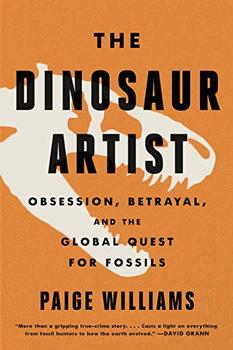Summary | Excerpt | Reviews | Beyond the Book | Readalikes | Genres & Themes | Author Bio

Obsession, Betrayal, and the Quest for Earth's Ultimate Trophy
by Paige WilliamsThis is a work of nonfiction. No names have been changed, no information invented. My reporting began in 2009, but for the purposes of the book's final form the immersive research occurred between 2012 and 2018. In the United States, I reported in Arizona, Connecticut, Florida, Georgia, Massachusetts, Montana, New Jersey, New York, Pennsylvania, South Dakota, Virginia, Washington, DC, and Wyoming. In Mongolia, I reported in the Gobi Desert, Töv Province, and Ulaanbaatar. In Canada, I reported in Edmonton, Alberta. In Europe, I reported in Munich, Germany, and in Charmouth, London, and Lyme Regis, England.
The information that I gleaned from interviews with paleontologists, geologists, fossil dealers, preparators, collectors, museum curators, auctioneers, law enforcement, and various government agents may not appear in full here, yet these generous people's insights informed the work. Written source material, some of it obtained through the Freedom of Information Act, included unclassified and declassified U.S. embassy cables and State Department reports, civil lawsuits, Department of Justice criminal case files and asset forfeiture records, library collections, news archives, peer-reviewed research papers, and county court documents. I also relied upon sources' personal photos, videos, correspondence, and papers. Mongolian documents were translated by Mongolians unrelated to the Mongolian government or the T. bataar case.
Much of this book grew out of "Bones of Contention," a piece that I wrote for The New Yorker in January 2013. There, as here, I tried to convey the nuances of the debate over who owns, or should be allowed to collect and own, natural history, and how that conflict may in turn affect a range of interests, including public policy, science, museums, and geopolitics. Various scenes I observed directly. For convenience, I occasionally interchange "dinosaur," "fossil dinosaur," and "skeleton"—writing that someone "bought a dinosaur" I of course refer to the extinct animal's stony remains. Likewise, I occasionally use "bone" for "fossil," having explained that fossilization yields rock. The title The Dinosaur Artist is not intended to refer exclusively to a leading subject of this book, Eric Prokopi, but rather also to dinosaurs' unparalleled power to remain culturally, scientifically, and aesthetically relevant despite extinction, and to the long, crucial intersection between science and art. Some readers may also choose to infer the formal definition of the word: "a habitual practitioner, of a specified reprehensible activity."
When speaking, some scientists refer to natural history museums by their acronyms ("AMNH" instead of "the AMNH"); although "the AMNH" clangs in my ear, I use that construction for clarity. I've borrowed slivers of my own language from the original New Yorker piece and from a Smithsonian article I later wrote about the endangered takhi horse, a creature that was a divine thrill to see in person on the Mongolian steppe.
INTRODUCTION: ORIGINS
In the summer of 2009, I came across a newspaper item about a Montana man convicted of stealing a dinosaur. The idea sounded preposterous. How was stealing a dinosaur even possible? And who would want to?
Nearly a decade earlier, this man, Nate Murphy, who led fossil-hunting tours in a geological signature in Montana called the Judith River Formation, had become well known for unveiling Leonardo, a late Cretaceous Brachylophosaurus and one of the best-preserved dinosaur skeletons ever found. A volunteer fossil hunter named Dan Stephenson had found the skeleton during one of Murphy's excursions on a private ranch near the small town of Malta. The remains constituted the first sub-adult of its kind on record and, remarkably, still bore traces of "skin, scales, muscle, foot pads—and even his last meal in his stomach," National Geographic reported. "To find one with so much external detail available, it's like going from a horse and buggy to a steam combustion engine," Murphy told the magazine. "It will advance our science a quantum leap."
Excerpted from The Dinosaur Artist by Paige Williams. Copyright © 2018 by Paige Williams. Excerpted by permission of Hachette Books. All rights reserved. No part of this excerpt may be reproduced or reprinted without permission in writing from the publisher.
Who dares to teach must never cease to learn.
Click Here to find out who said this, as well as discovering other famous literary quotes!
Your guide toexceptional books
BookBrowse seeks out and recommends the best in contemporary fiction and nonfiction—books that not only engage and entertain but also deepen our understanding of ourselves and the world around us.